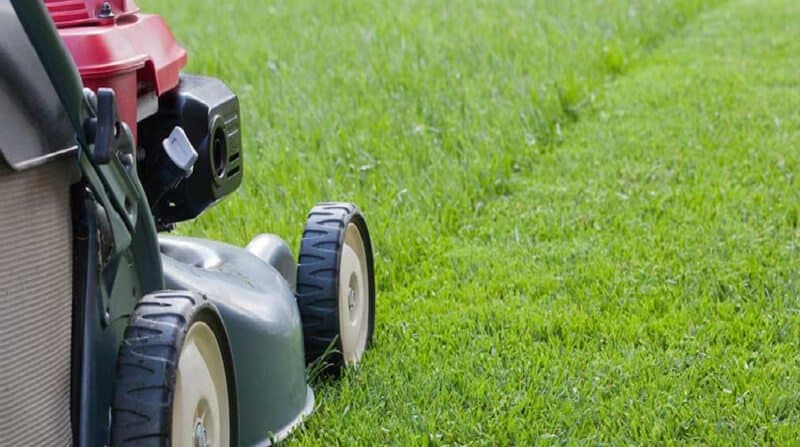Mowing the lawn is the most important and time-consuming part of lawn care.
The time of year and the weather it brings will affect how often you mow as well as how high you mow.
This article will explain when to cut the grass depending on the season.
A Typical Mowing Calendar
The mowing calendar generally starts in March and ends in October. However, this very much depends on the weather and where you live.
For example, if you live in the south of England you’ll generally start mowing a couple of weeks earlier than if you live in the North of Scotland. Simply because it’s typically warmer in the south.
So this schedule is typical for someone living in the middle of the UK.
March
You’ll normally see the first signs of grass growth in March so give the lawn its first cut of the year.
If you don’t see signs of growth, don’t mow until you do.
Conditions are often still quite cool and growth is slow. As such, it’s really important that you only take the top off the grass.
Cutting grass too short now can stunt its growth and the rain at this time of year can cause moss to spore. If you mow too low and shock the grass, it won’t be able to fight off a moss invasion so you could find yourself having to fight the moss in April.
So, keep your lawn mower on its highest setting and only take the top off the grass.
Also, mow on a dry day.
April
April really heralds the start of the lawn calendar.
The rising temperatures and plenty of rainfall make for excellent growing conditions.
You’ll want to mow at least every 10 days and depending on how quickly the grass is growing, you might need to cut every 7 days. Also, cut the grass when it’s dry as cutting wet grass is never recommended.
This is the perfect time to start reducing the height of your lawn mower if you like a shorter cut.
It’s important to reduce the height of long grass gradually. Never remove more than a third of the grass leaf at a time. See my guide to learn how to cut long grass.
April is also a good time to edge your lawn if it needs re-shaping.
May/June
By now you should have reduced the height of your lawn down to your preferred length.
To maintain that height you’ll need to mow before it grows by a third.
So if you like your lawn at 5cm high, you’ll need to mow before or when gets to 6.5cm. This means you might have to increase your mowing frequency to once every 5-7 days.
July/August
As the weather heats up and the rain becomes less frequent, grass growth will slow down. Take your mowing schedule back to every 10 days.
If it’s hot and dry with very little rainfall, raise the height of your lawnmower. Cutting the grass too short now you’ll be taking away vital food stores that give grass its ability to survive drought.
If your lawn is free of weeds and you own a lawn mower that mulches, mulching the grass clippings and leaving them on your lawn will recycle the moisture and nutrients. It’s a good idea to mulch grass clippings all through the growing season. However, it’s is especially important in the heat of the summer.
It’s easier to do this if you have a lawn mower that mulches.
September
September usually marks the start of Autumn with the return of the rains. There’s still plenty of sun and the warmth in the soil makes for excellent growing conditions.
Increase the regularity at which you mow the lawn again to once a week. You can also reduce the cutting height again.
That said, if your lawn is prone to suffering from moss attacks, keep the mower on the high side.
The regular mowing will stimulate new grass growth from the base of the plant making less room for moss to spore. Mowing on a higher setting keeps the grass long and as strong as possible, depriving any moss of the light it needs to grow.
October
Regular mowing will all but stop in October and you’ll probably give your grass its last cut of the year.
You should keep the grass on the high side so the grass can keep as much of its food store as possible.
This will give it the best chance of staying strong through the winter and make it more able to fight off moss infestations and disease.
November to March
You might want to mow the lawn at any time in the winter to take the top off the grass and keep your lawn looking neat and tidy. Afterall, your lawn shouldn’t look untidy just because it’s winter.
It’s really important to set your mower to its highest setting and only take the top off the grass.
Only mow the lawn when the ground is firm. Do it on a dry day and never cut the grass when it’s frosty or when frost is due.
If in doubt, don’t bother at all.
In Conclusion
As you can see, when to cut grass all depends on the time of year.
You can have one of the top rated lawnmowers in the world but if you mow too short or don’t mow often enough, your lawn will suffer.
Regular mowing at the right height for the time of year will have a massive impact on the overall health and appearance of your lawn.


Really, seriously, excellent overview. Love the monthly approach and clarity. Not a single thing said leaves me with more questions. Gonna leave my lawn alone for winter despite the growth due to some warm rains in October and November. Thanks from the Toronto area!